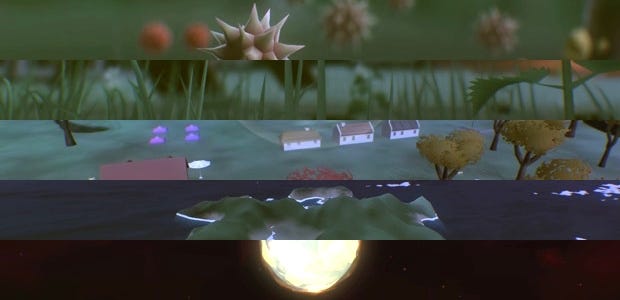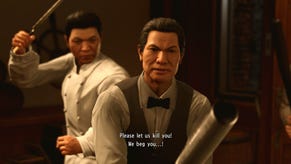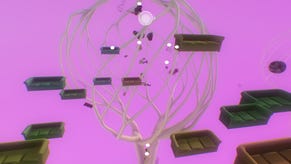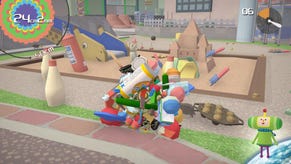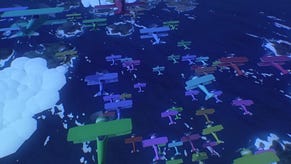How Everything conjures infinity with camera tricks
Everything explained
This is The Mechanic, where Alex Wiltshire invites developers to discuss the inner workings of their games. This time, Everything [official site].
Everything is a game about everything. You can play as everything. Planets and hairs, whales and articulated buses. Pollen, spiral galaxies, tents, penguins - you get the picture. Within a few seconds, you might have moved from being a tardigrade floating on the microscopic scale all the way to being a sun hanging in a star-flecked universe. But the transitions, as you scale from from tardigrade to clump of grass to chimpanzee to forest to continent to planet to sun, feel remarkably smooth, even magical, reflecting the game’s core philosophical message: that everything is related and part of a whole, and that we are natural a part of it all too.
Under that smoothness lie a lot of design tricks by its creators, David O’Reilly and Damien Di Fede, all centred on something it’s very easy to take for granted:
THE MECHANIC: Thirdperson cameras
If you haven’t played Everything, it’s a mediative kind of a game, sometimes profound, sometimes ridiculous, and often both at the same time. As you take control of a new thing, perhaps larger or smaller, the world contracts to the tiny and expands up to the universal and, eventually, the abstract, as you encounter a dimension of geometry that exists above the galaxy scale. And what lies above the conceptual scale? You circle back to the microscopic.
Believe it or not, Everything doesn’t continually draw an endlessly recursive single world that dynamically scales from the minute to the conceptual and back again. Instead, it’s composed of a series of pre-designed scenes, encompassing seven different scale levels which its makers call particle, tiny, human, landmass, planet, galaxy, and collapse, which is their name for the abstract dimension. And within the tiny to landmass scales there are six different environments: green forest, sand, ice, city, water and alien.
And yet the transitions between them feel smooth, both visually and cognitively, despite the game having to fundamentally ditch a complete level and exchange it for another one. “It’s basically just a magic trick, where we distract your attention to one place while doing stuff in another,” programmer Di Fede tells me. It all happens during the swoop the camera makes as it moves from the perspective of your old character - Di Fede calls the objects you can control characters, even if they’re a rock or convex stellated polyhedron - to that of your new one.
OK, so you’re a horse at the human scale, and you’re going to go down to the level of a clump of grass. The first half of the camera move is zooming towards that clump of grass. As it does so, the game hides all characters in the human scale, and then it switches scene to the tiny scale, snapping the camera to a new location above the grass to start the second half of the transition. It then zooms down to complete the transition.
So in effect, there are two entirely different camera movements, but they’re joined together by a series of subtle tricks. The main one is a system that maintains the same camera angle on the new character as the previous camera began to swoop down to it. By keeping that angle, continuity is created and the player’s attention isn’t distracted.
The game pulls more tricks besides. When the view zooms down from the horse to the clump of grass, it also captures a skybox from the old scene and uses it in the new one. So if there was a tree in view in the old scene, you’ll still see it, blurred and distant, looming above you. “If you’re watching you can see it pop, but generally people aren’t watching because the camera motion draws their eye to the thing they’re travelling into,” says Di Fede. “So by the time they look up and see the skybox it’s already been switched.”
There are some cases, however, where the game doesn’t keep the same camera angle, such as when a player is zooming from a planet down to a landmass. Here, instead the camera flies to the edge of the planet, and then on the scene transition it looks directly down as it falls towards the island you’re about to control, before softening out towards the thirdperson camera angle you’ll be using to control it.
“Conceptually, you’re coming from space,” says Di Fede, explaining how maintaining continuity is not simply visual, it’s also a matter of context and player expectation. “When you come from space to a planet you’re coming directly from above, not from a 45 degree angle or anything like that.”
Context and expectation are a big part of the sense of smoothness in Everything’s scale transitions, and they’re quietly supported by the way the game chooses the characters you’ll be transitioning into. When you want to change characters, you hold the left or right mouse buttons to find characters to ascend or descend into and the game displays an aiming reticle and shapes you can move it over in order to select them. But from all the characters around you, it only gives a few to choose from.
“Oftentimes that’s based on characters that are larger than a particular size, because we don’t want you to be going from the human scale to the tiny scale and jumping directly into the smallest thing that’s there,” says Di Fede. “Sometimes we don’t want you to be entering particular types of characters, like flying characters. If you go from being a continent, we don’t want you to end up in a bird that’s way above the ground, we want you to be on the ground because that’s where it feels you’re going.”
They also didn’t want the game to select characters that are behind the player, so they’re always in view, and it also needs to know what your old character is standing in, in case it affects what it’ll move down to. If you’re standing on a pond, for instance, you’ll transition down into an underwater scene, and if you’re on grass, you’ll go down to a grass scene.
So the game analyses what is around you in the world and at the next scale up or down, looking at all the characters that are present and filtering them according to the parameters Di Fede and O’Reilly set, and then chooses one at random from what’s left. But as you make transitions into the next scale, it doesn’t simply spawn that character into the world for you to play as. Each one was originally carefully placed in the scenes by O’Reilly and they’re saved as you play. When you switch into controlling an armadillo, it really was there in the world, the game exchanging its AI for your control.
Various extra little touches give hints as to the relative size of the character you’ll be selecting by making its circle slightly larger or smaller, and you might also notice that the game presents the different scales with different FOV settings and depth of field effects to give a greater sense of their nature. The human scale is 60 degrees, similar to a standard thirdperson videogame. But it’s wider at the tiny scale, but with thick blurring of distant objects to give a sense of being a small thing in a wider world.
From all these camera tricks, Everything creates the sense of freewheeling infinity from a pragmatic reality of limited game assets and processing power. By keeping your eye and mind fixed on the surprise and wonder of what lies beneath and above, Everything conjures, well, everything.
